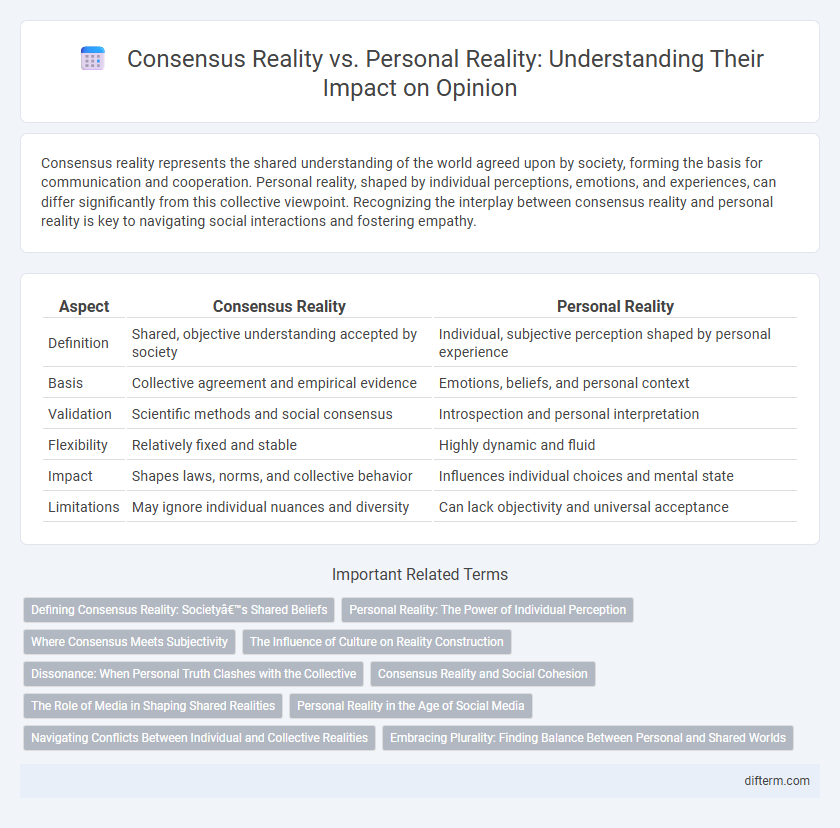Consensus reality represents the shared understanding of the world agreed upon by society, forming the basis for communication and cooperation. Personal reality, shaped by individual perceptions, emotions, and experiences, can differ significantly from this collective viewpoint. Recognizing the interplay between consensus reality and personal reality is key to navigating social interactions and fostering empathy.
Table of Comparison
| Aspect | Consensus Reality | Personal Reality |
|---|---|---|
| Definition | Shared, objective understanding accepted by society | Individual, subjective perception shaped by personal experience |
| Basis | Collective agreement and empirical evidence | Emotions, beliefs, and personal context |
| Validation | Scientific methods and social consensus | Introspection and personal interpretation |
| Flexibility | Relatively fixed and stable | Highly dynamic and fluid |
| Impact | Shapes laws, norms, and collective behavior | Influences individual choices and mental state |
| Limitations | May ignore individual nuances and diversity | Can lack objectivity and universal acceptance |
Defining Consensus Reality: Society’s Shared Beliefs
Consensus reality represents the collective beliefs and shared understandings that a society agrees upon as truth, shaping norms, values, and behaviors within a community. This societal framework is constructed through language, culture, and social institutions, creating a common reference point for interpreting experiences. While personal reality is subjective and individual, consensus reality provides stability and coherence by aligning diverse perspectives into an accepted social narrative.
Personal Reality: The Power of Individual Perception
Personal reality shapes one's experience through unique perspectives and subjective interpretation of events. This individualized perception influences emotions, decisions, and beliefs, often contrasting with the consensus reality shared by society. Embracing personal reality empowers self-awareness and authenticity, highlighting the significance of individual meaning-making in a complex world.
Where Consensus Meets Subjectivity
Consensus reality serves as the shared framework of facts and experiences agreed upon by a community, grounding social interactions and collective understanding. Personal reality, shaped by individual perception, emotions, and memories, introduces subjective nuances that challenge and enrich this collective framework. The intersection of consensus and personal realities reveals the dynamic tension where objective truths meet diverse human experiences, fostering both conflict and growth in social discourse.
The Influence of Culture on Reality Construction
Culture profoundly shapes consensus reality by providing shared symbols, language, and values that define a collective understanding of the world. Personal reality, while unique to the individual, is simultaneously influenced by these cultural frameworks, which act as lenses through which experiences are interpreted. Variations in cultural contexts result in diverse constructions of reality, highlighting the dynamic interplay between collective norms and individual perception.
Dissonance: When Personal Truth Clashes with the Collective
Dissonance emerges when personal reality conflicts with consensus reality, creating a psychological tension that challenges individual beliefs and societal norms. This clash often leads to cognitive dissonance, where the mind struggles to reconcile conflicting worldviews, potentially resulting in discomfort or social alienation. Understanding this dynamic is crucial for navigating the balance between authentic self-expression and collective agreement.
Consensus Reality and Social Cohesion
Consensus reality serves as the foundational framework through which societies establish shared understandings and norms, enabling effective communication and cooperation. Social cohesion depends heavily on this collective agreement, as it fosters trust, predictability, and stability within communities. When consensus reality is maintained, it reduces conflicts and enhances collective problem-solving, reinforcing societal bonds and promoting harmonious coexistence.
The Role of Media in Shaping Shared Realities
Media acts as a powerful architect of consensus reality by selectively framing events, influencing public perception, and amplifying dominant narratives that shape collective understanding. Algorithms and editorial biases reinforce echo chambers, limiting exposure to diverse perspectives and thus narrowing the scope of shared realities. Consequently, the interplay between media consumption and individual cognition highlights the tension between consensual truths and personal realities shaped by subjective experiences.
Personal Reality in the Age of Social Media
Personal reality in the age of social media is increasingly shaped by curated content and echo chambers, leading to individualized perceptions of truth that often diverge from consensus reality. Algorithms prioritize engagement, reinforcing existing beliefs and creating personalized realities that may hinder objective understanding. This dynamic challenges traditional notions of shared reality, emphasizing the subjective nature of experience brought forth by digital interaction.
Navigating Conflicts Between Individual and Collective Realities
Conflicts between consensus reality and personal reality often arise when individual beliefs challenge widely accepted norms, complicating social cohesion and communication. Navigating these conflicts requires acknowledging the validity of subjective experiences while maintaining respect for shared facts that uphold collective understanding. Effective dialogue and empathy enable reconciliation between personal perspectives and communal realities, fostering mutual respect without eroding foundational truths.
Embracing Plurality: Finding Balance Between Personal and Shared Worlds
Consensus reality provides a common framework of agreed-upon facts and social norms that enable collective understanding and cooperation. Personal reality, shaped by individual perceptions and experiences, offers unique insights and fosters creativity. Embracing plurality means valuing both shared truths and personal perspectives to achieve a balanced worldview that respects diversity while maintaining social cohesion.
consensus reality vs personal reality Infographic

 difterm.com
difterm.com